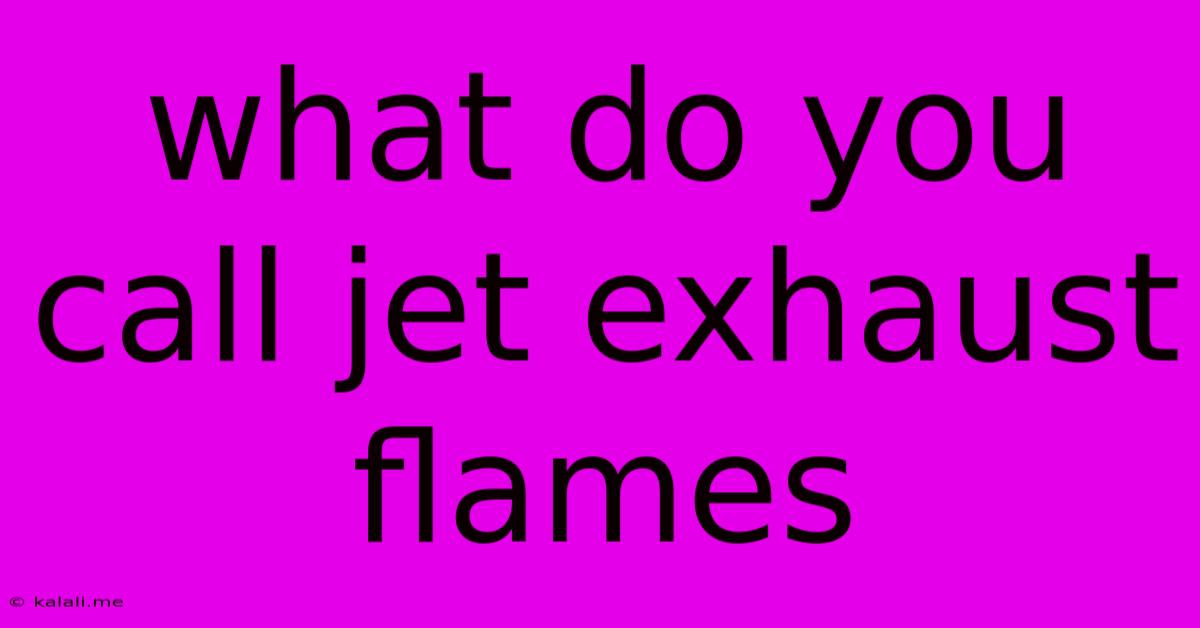What Do You Call Jet Exhaust Flames
Kalali
Jun 01, 2025 · 3 min read

Table of Contents
What Do You Call Jet Exhaust Flames? Understanding the Fiery Plume of a Jet Engine
Have you ever watched a jet plane take off, mesmerized by the powerful roar and the dramatic plume of fire trailing behind it? That fiery spectacle isn't simply flames, but a complex mixture of hot gases and particles. While commonly referred to as "flames," the technically accurate term depends on the specific aspects you're describing. This article will delve into the nuances of jet exhaust and the various terms used to describe its visible components.
What are the components of jet exhaust?
A jet engine's exhaust isn't just one thing; it's a complex mixture of several elements, primarily:
- Hot Gases: The primary component is superheated gases, mainly air and combustion products (carbon dioxide, water vapor, nitrogen oxides). These gases are the source of the jet's thrust.
- Water Vapor: A significant byproduct of combustion is water vapor. Depending on atmospheric conditions (humidity and temperature), this vapor can condense, creating a visible plume.
- Soot and Particles: Incomplete combustion can result in the production of soot and other unburnt particles. These contribute to the darker appearance of the exhaust plume, especially at lower altitudes.
- Condensed Water: As mentioned, the water vapor in the exhaust can condense into tiny water droplets, particularly when the exhaust gases encounter cooler, moist air. This condensation is what often creates the visible "cloud" or "plume" behind the jet.
So, what do you actually call those fiery trails?
There's no single universally accepted term, and the best descriptor depends on the context:
- Jet Blast/Jet Wash: This term generally refers to the high-velocity stream of hot gases exiting the engine. It encompasses the entire exhaust flow, not just the visible components. This is the most encompassing and accurate general term.
- Exhaust Plume: This is a more descriptive term that specifically refers to the visible trail of gases and particles left behind the aircraft. This term accurately captures the visual effect.
- Contrail (Condensation Trail): If the visible trail is primarily composed of condensed water vapor, it's more accurately referred to as a contrail. Contrails form when the water vapor in the exhaust cools and condenses in the cold, dry upper atmosphere, creating a visible trail.
- Smoke Plume (or Soot Plume): If the plume is visibly dark and smoky, due to unburnt fuel or other particles, it's often described as a smoke plume or soot plume, indicating incomplete combustion.
Factors influencing the appearance of jet exhaust:
Several factors influence the appearance of the exhaust plume:
- Altitude: At higher altitudes, the air is colder and drier, leading to more prominent contrails. Lower altitudes typically result in less visible condensation, and potentially more soot.
- Humidity: Higher humidity increases the likelihood of visible condensation and larger plumes.
- Engine Type: Different engine designs produce different exhaust characteristics.
- Fuel Type: The composition of the fuel used can influence the amount of soot and other particles in the exhaust.
Understanding the nuances of jet exhaust terminology allows for a more accurate and precise description of this fascinating phenomenon. While "flames" might be a common term, using more specific vocabulary provides a richer understanding of the complex processes at play. Remember to consider the altitude, atmospheric conditions, and the overall visual characteristics of the plume when choosing the most appropriate descriptor.
Latest Posts
Latest Posts
-
How Often Do You Need To Change Spark Plugs
Jun 03, 2025
-
Do I Check Oil With Car Running
Jun 03, 2025
-
What Sword Does A Ranger Class Use
Jun 03, 2025
-
Neutral Ground Bond To Be Inside
Jun 03, 2025
-
What Shoes Can You Wear In Lab
Jun 03, 2025
Related Post
Thank you for visiting our website which covers about What Do You Call Jet Exhaust Flames . We hope the information provided has been useful to you. Feel free to contact us if you have any questions or need further assistance. See you next time and don't miss to bookmark.